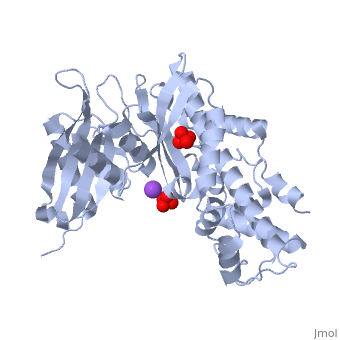1v4t
From Proteopedia
(Difference between revisions)
| Line 3: | Line 3: | ||
== Structural highlights == | == Structural highlights == | ||
<table><tr><td colspan='2'>[[1v4t]] is a 1 chain structure with sequence from [http://en.wikipedia.org/wiki/Homo_sapiens Homo sapiens]. Full crystallographic information is available from [http://oca.weizmann.ac.il/oca-bin/ocashort?id=1V4T OCA]. For a <b>guided tour on the structure components</b> use [http://oca.weizmann.ac.il/oca-docs/fgij/fg.htm?mol=1V4T FirstGlance]. <br> | <table><tr><td colspan='2'>[[1v4t]] is a 1 chain structure with sequence from [http://en.wikipedia.org/wiki/Homo_sapiens Homo sapiens]. Full crystallographic information is available from [http://oca.weizmann.ac.il/oca-bin/ocashort?id=1V4T OCA]. For a <b>guided tour on the structure components</b> use [http://oca.weizmann.ac.il/oca-docs/fgij/fg.htm?mol=1V4T FirstGlance]. <br> | ||
| - | </td></tr><tr><td class="sblockLbl"><b>[[Ligand|Ligands:]]</b></td><td class="sblockDat"><scene name='pdbligand=NA:SODIUM+ION'>NA</scene>, <scene name='pdbligand=SO4:SULFATE+ION'>SO4</scene>< | + | </td></tr><tr id='ligand'><td class="sblockLbl"><b>[[Ligand|Ligands:]]</b></td><td class="sblockDat"><scene name='pdbligand=NA:SODIUM+ION'>NA</scene>, <scene name='pdbligand=SO4:SULFATE+ION'>SO4</scene></td></tr> |
| - | <tr><td class="sblockLbl"><b>Activity:</b></td><td class="sblockDat"><span class='plainlinks'>[http://en.wikipedia.org/wiki/Hexokinase Hexokinase], with EC number [http://www.brenda-enzymes.info/php/result_flat.php4?ecno=2.7.1.1 2.7.1.1] </span></td></tr> | + | <tr id='activity'><td class="sblockLbl"><b>Activity:</b></td><td class="sblockDat"><span class='plainlinks'>[http://en.wikipedia.org/wiki/Hexokinase Hexokinase], with EC number [http://www.brenda-enzymes.info/php/result_flat.php4?ecno=2.7.1.1 2.7.1.1] </span></td></tr> |
| - | <tr><td class="sblockLbl"><b>Resources:</b></td><td class="sblockDat"><span class='plainlinks'>[http://oca.weizmann.ac.il/oca-docs/fgij/fg.htm?mol=1v4t FirstGlance], [http://oca.weizmann.ac.il/oca-bin/ocaids?id=1v4t OCA], [http://www.rcsb.org/pdb/explore.do?structureId=1v4t RCSB], [http://www.ebi.ac.uk/pdbsum/1v4t PDBsum]</span></td></tr> | + | <tr id='resources'><td class="sblockLbl"><b>Resources:</b></td><td class="sblockDat"><span class='plainlinks'>[http://oca.weizmann.ac.il/oca-docs/fgij/fg.htm?mol=1v4t FirstGlance], [http://oca.weizmann.ac.il/oca-bin/ocaids?id=1v4t OCA], [http://www.rcsb.org/pdb/explore.do?structureId=1v4t RCSB], [http://www.ebi.ac.uk/pdbsum/1v4t PDBsum]</span></td></tr> |
| - | <table> | + | </table> |
== Disease == | == Disease == | ||
[[http://www.uniprot.org/uniprot/HXK4_HUMAN HXK4_HUMAN]] Defects in GCK are the cause of maturity-onset diabetes of the young type 2 (MODY2) [MIM:[http://omim.org/entry/125851 125851]]; also shortened MODY-2. MODY is a form of diabetes that is characterized by an autosomal dominant mode of inheritance, onset in childhood or early adulthood (usually before 25 years of age), a primary defect in insulin secretion and frequent insulin-independence at the beginning of the disease.<ref>PMID:1502186</ref> <ref>PMID:1464666</ref> <ref>PMID:1303265</ref> <ref>PMID:8495817</ref> <ref>PMID:8325892</ref> <ref>PMID:8446612</ref> <ref>PMID:8168652</ref> <ref>PMID:9049484</ref> <ref>PMID:10694920</ref> <ref>PMID:9662401</ref> <ref>PMID:10588527</ref> <ref>PMID:11106831</ref> <ref>PMID:11372010</ref> Defects in GCK are the cause of familial hyperinsulinemic hypoglycemia type 3 (HHF3) [MIM:[http://omim.org/entry/602485 602485]]; also known as persistent hyperinsulinemic hypoglycemia of infancy (PHHI) or congenital hyperinsulinism. HHF is the most common cause of persistent hypoglycemia in infancy. Unless early and aggressive intervention is undertaken, brain damage from recurrent episodes of hypoglycemia may occur.<ref>PMID:9435328</ref> | [[http://www.uniprot.org/uniprot/HXK4_HUMAN HXK4_HUMAN]] Defects in GCK are the cause of maturity-onset diabetes of the young type 2 (MODY2) [MIM:[http://omim.org/entry/125851 125851]]; also shortened MODY-2. MODY is a form of diabetes that is characterized by an autosomal dominant mode of inheritance, onset in childhood or early adulthood (usually before 25 years of age), a primary defect in insulin secretion and frequent insulin-independence at the beginning of the disease.<ref>PMID:1502186</ref> <ref>PMID:1464666</ref> <ref>PMID:1303265</ref> <ref>PMID:8495817</ref> <ref>PMID:8325892</ref> <ref>PMID:8446612</ref> <ref>PMID:8168652</ref> <ref>PMID:9049484</ref> <ref>PMID:10694920</ref> <ref>PMID:9662401</ref> <ref>PMID:10588527</ref> <ref>PMID:11106831</ref> <ref>PMID:11372010</ref> Defects in GCK are the cause of familial hyperinsulinemic hypoglycemia type 3 (HHF3) [MIM:[http://omim.org/entry/602485 602485]]; also known as persistent hyperinsulinemic hypoglycemia of infancy (PHHI) or congenital hyperinsulinism. HHF is the most common cause of persistent hypoglycemia in infancy. Unless early and aggressive intervention is undertaken, brain damage from recurrent episodes of hypoglycemia may occur.<ref>PMID:9435328</ref> | ||
| Line 39: | Line 39: | ||
[[Category: Hexokinase]] | [[Category: Hexokinase]] | ||
[[Category: Homo sapiens]] | [[Category: Homo sapiens]] | ||
| - | [[Category: Eiki, J | + | [[Category: Eiki, J]] |
| - | [[Category: Kamata, K | + | [[Category: Kamata, K]] |
| - | [[Category: Mitsuya, M | + | [[Category: Mitsuya, M]] |
| - | [[Category: Nagata, Y | + | [[Category: Nagata, Y]] |
| - | [[Category: Nishimura, T | + | [[Category: Nishimura, T]] |
[[Category: Allosteric enzyme]] | [[Category: Allosteric enzyme]] | ||
[[Category: Diabetes]] | [[Category: Diabetes]] | ||
[[Category: Hexokinase iv]] | [[Category: Hexokinase iv]] | ||
[[Category: Transferase]] | [[Category: Transferase]] | ||
Revision as of 12:32, 6 January 2015
Crystal structure of human glucokinase
| |||||||||||
Categories: Hexokinase | Homo sapiens | Eiki, J | Kamata, K | Mitsuya, M | Nagata, Y | Nishimura, T | Allosteric enzyme | Diabetes | Hexokinase iv | Transferase


